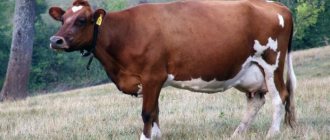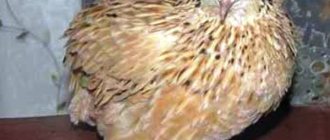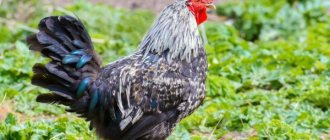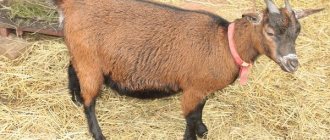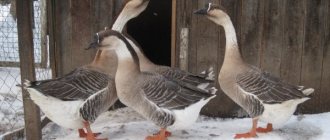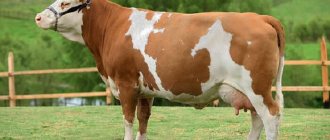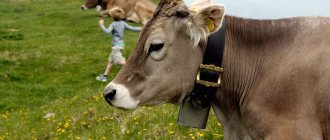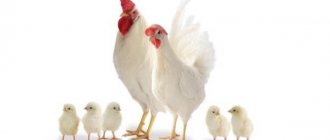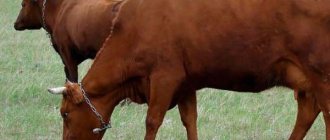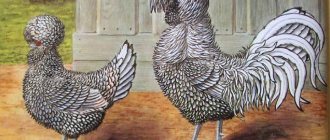Character and exterior
Mostly the Yaroslavl cow is black in color, but it can also be red-and-white and black-and-white. The main differences between these cows are thin and low hooves, light horns, and they are dark at the end. The face is white with the presence of dark glasses. The head is narrow and at the same time dry.
The structure of the Yaroslavl cow is pronounced, milky, the bones are strong, the body is elongated, the general shape is angular. There is a thin layer of subcutaneous fat; the muscles of both cows and bulls are not very well developed.
In addition to this, there are other features of Yaroslavl cattle:
- narrow but deep sternum;
- quite wide rear;
- the neck is long and covered with folds;
- the withers are high;
- the belly is large, where the ribs are widely spaced.
The face, belly, tip of the tail and legs are white, and the nose is mostly black.
Description of appearance and performance data
Color: the skin of these cows is predominantly black or black-red, but there are always white spots-marks on the face, udder or hooves.
The physique itself is somewhat angular. Cows have a strong constitution and average development. Bulls have strong bones. The head is dry, light, the front part of the muzzle is retracted, the nasolabial mirror is often black, and the horns are light whitish. The neck is thin, of normal length, with small folds.
Muscles are underdeveloped, thin skin, small legs.
Typical parameters for this breed are as follows:
- at the withers - up to 127 cm;
- “oblique line” - 152–155 cm;
- chest depth - 66–70 cm;
- metacarpal girth - 17–18 cm.
The udder is large, wide-rounded, the nipples are widely spaced, of medium length, the front ones are spaced apart more than the rear ones. Udder index - 40–44%.
An adult cow weighs 400–550 kg.
Milk productivity of cows of the Yaroslavl breed is 4–5 tons.
The slaughter yield of meat for cows is 53–55%, for fattening bulls it reaches 58%.
Spreading
In former times, the Yaroslavl cattle breed was popular in the following areas:
- Yaroslavskaya;
- Ivanovskaya;
- Kalininskaya;
- Volgogradskaya;
- Kostroma;
- Tyumen
As of January 1, 1985, there were 800 thousand Yaroslavl cows and bulls in the state. The breed was bred due to the high demand for milk and beef by leaving the following cities in Russia:
- Moscow;
- Saint Petersburg;
- Yaroslavl.
Varieties
On farms you can see cows of a reddish-reddish color - this is a classic type of Hereford, they are characterized by the following features: white coloring of the muzzle, neck, sternum and withers, light horns gradually changing their color to a darker one, elongated body and low legs, behind them the animal looks squat, the mammary glands are barely visible.
Breed varieties:
- polled. The result of a natural mutation. It is distinguished by the complete absence of horns, which is inherited. Many farmers prefer this kind of livestock, because without horns, sexually mature animals do not harm each other when sorting out relationships.
- Black. Animals of this color were the result of crossing with a Holstein cow. Due to their large size, breeders breed them for meat.
- Black Baldi. To obtain meat for slaughter, Hereford bulls are crossed with the Aberdeen Angus breed. The calf is several times the size of its parents.
These representatives of cattle are the most sought after meat breed in the world. They do not require complex care, are unpretentious in food, live long and produce large offspring. Bull calves are sold wholesale and retail in Russia. Literally a few heads of cattle will help take farming to a whole new level, improving the performance of the entire herd.
Productive qualities
The productive qualities of Yaroslavl cows are at their best, especially regarding milk production. In addition, the cow copes well with reproductive function and after birth becomes a good mother.
Milk
The main advantage of this breed is its high milk production. The udder of these representatives is well developed, it has a round shape. One cow can produce from 3000 to 6000 liters of tasty milk in one year. As for the record holders, you can get as much as 12,000 liters of milk per year from them. A heifer who has given birth for the first time produces 2200 kg of milk in 12 months.
The fat content of milk is 4.5% and this is not a bad indicator. The product is often used not only in fresh form, but also in the production of cheeses, kefir, cottage cheese, butter, both at home and in industrial conditions. If milk yield exceeds 6000 kg, then the fat content of milk increases to 5.20%.
Meat
The weight of representatives of the Yaroslavl breed is considered large, but if we talk about meat traits, we can say that no selection has been carried out with this breed. For this reason, the yield of meat after slaughter is only 45%. The amount of meat can increase if you feed the animals with a large amount of protein (grain, good bran).
Yaroslavl cows have good reproductive functionality, as well as high calf productivity. Cows bear offspring without problems and give birth to healthy babies in 90% of cases. A newborn calf has 30 kg live weight. While breastfed and receiving good care, he will gain 800 grams per day. At one year of age, a bull can weigh 400 kg.
Milk productivity
In this regard, the Yaroslavl breed of cows, as already mentioned, is one of the best today. From one animal per year you can get up to 3000-6000 kg of milk.
At the same time, the milk yield from record holders is often 7000-8000 kg. First-born heifers produce about 2250 kg per year. The milk of these cows is quite fat - 4-4.5%.
It can be used not only for fresh consumption or making kefir, but also for the production of butter and cheese on an industrial scale.
If the milk yield exceeds 6000 kg, the fat content of the resulting product increases to 5.22%.
Cow management
Yaroslavl cows do not require close attention, special conditions of care and maintenance. But it is still worth noting some recommendations regarding the content:
- at the end of autumn, the barn should be insulated and disinfected;
- it is necessary to ensure that there are no drafts in the room;
- windows are installed high;
- Cow hygiene is important, namely washing the entire body and adjusting the legs;
- To prevent animals from getting sick, the premises must be cleaned daily;
- to avoid mastopathy, females should regularly change their bedding;
- in the barn you need to monitor the air temperature; high temperatures should not be allowed;
- the cow should be milked at a certain time;
- there should be a lake or river near the walking area;
- the first days the animals are grazed for 2 hours, gradually increasing the time to 16 hours;
- once a month it is necessary to call a veterinarian to examine the animals and systematically carry out the necessary vaccinations.
On the territory where the cattle will live their lives, 3 premises should be built:
- Cowshed. It is built from adobe, brick or ordinary logs.
If you build a barn out of brick, the building will be cold; animals may get sick in the cold season. During construction, it is necessary to calculate the area per cow, then multiply this number by the number of all cows. For one head you need 6 square meters, if you plan to raise a heifer, then you need to allocate 10 square meters here. It is recommended to insulate the floor or at least lay out a thick layer of bedding; it should also be at a 3-centimeter slope. From the inside, you need to separate a space for a stall measuring 1.7 by 1.1 meters, in front of which a feeder and drinking bowl are installed. - Manure storage. To do this, it is enough to make a square of 2.5 by 2.5 meters, given that in one year approximately 10 tons of manure will be removed from one livestock.
- Shed for storing feed. It can be built from ordinary boards. The supply of hay is placed in a room whose area is 10 by 4 by 3 meters. Hay can also be stored simply in a stack under a small canopy.
Care
A cow that has just given birth requires special care. The feed should be increased every day, gradually reaching the previous amount. For the first 3 days, the animal should be fed 5 times a day. Before each milking, the udder is washed with warm water and massaged exclusively with warm hands, otherwise mastitis may occur.
To obtain high milk productivity, milking should be done at the same time, after stroking the udder with your hands. It is necessary to milk until the last drop to avoid problems, and after finishing, do a light massage again.
Nutrition
As for the nutrition of Yaroslavl cows and bulls, voluminous forms of feed are important, but the amount of food consumed must be controlled. The diet is made up of the feed that is available.
The diet of dairy cows of this breed may contain half of the voluminous feed from the entire dacha, in summer even more - 68%. Rough feed (hay, straw, chaff, chaff) can be fed from 30 to 50%.
The table describes the difference in feeding depending on the time of year, productivity, calving, new calving, milk yield, etc.
| Season (winter and summer) | Feeding characteristics related to reproduction | Features of feeding during pregnancy and lactation | Feeding fresh cows | Feeding cows during milking | Feeding during the grazing period |
| In winter, cows and bulls should be given 33% silage and 33% haylage, as well as 10% sugar beets. In summer, green food should account for 2/3 of the total volume. | The volume of feed or meal is determined by the volume of the main feed in the diet (grass or hay) and the amount of milk given. For example, if milk yield is 4.5 tons per year or more, then the cow is fed combined feed (loose feed). | One and a half months before the expected date of birth, the Yaroslavl breed is transferred to dry wood. This should be done gradually and the diet should also be changed slowly. Succulent feed is reduced - grass, silage, beets and concentrates (meal, mixed feed) until complete failure, leaving only hay. The amount of water is reduced; if the cow gives a lot of milk, then 3 buckets of water can be given per day, and if it is not enough, then 2 buckets. | 7 days before birth, succulent feed, root vegetables, silage and preservatives are completely excluded. What you can feed during this period is forb and meadow hay. Three days after giving birth, the cow is gradually given silage, haylage, and root vegetables, constantly increasing the dose. | The feed continues to be increased during milking until the cow increases the amount of milk she gives. Hay, silage and haylage can be given in unlimited quantities. With average milk yield, the animal is fed twice a day, with high milk yields - three times a day. | The transfer of animals to grazing should occur gradually in order to avoid a decrease in milk production. Initially, the cow is kept out for 2-3 hours, having previously fed her half of the total feed. |
Read about the features of feeding calves from birth here.
Diseases
The most important characteristic of the Yaroslavl cow is good immunity. They almost never get sick and can even prevent infection with leukemia. Experts believe that it is representatives of this breed that are most rarely exposed to this pathology. If one animal from the entire herd gets sick, the rest will still not become infected. An infected cow is not treated; it is immediately sent to slaughter.
Common diseases that Yaroslavl cows rarely suffer from:
| Name of the disease | Description |
| Paratuberculous enteritis | The animal becomes infected through the gastrointestinal tract; it does not lose its appetite, but diarrhea occurs around the clock. If the pathology is not treated in a timely manner, the cow may die due to exhaustion. |
| Vibriosis | This disease is chronic. During mating, the animal can become infected from a sexual partner and have a miscarriage. |
| Stomatitis | This disease is an inflammatory process in the mouth. This can occur due to the consumption of roughage or chemicals that can injure the mucous membrane. |
| Esophageal blockage | This pathology can strike when eating large pieces of root vegetables, severe fright while eating and spasm, the esophagus can close with a foreign object. |
| Scar swelling | The rumen may swell if the cow eats feed after rain or dew, or if she eats low-quality feed. |
History of the breed
The approval of the breed characteristics of individuals was carried out at the beginning of the 20th century. The ancestors of the Yaroslavl cow were selected based on their appearance. Animals of this breed took part in exhibitions organized by control associations of agricultural workers.
During the Revolution, breeding work had to be suspended for some time, however, after 1924 it was continued by large partnerships. The breeding of livestock was carried out on the territory of breeding nurseries in Russia. In 1937, East Frisian bulls were used to inseminate heifers. However, as a result of such actions of breeders, the fat content of dairy products has decreased.
Many years later, until 1980, the milk productivity of Yaroslavl cows was increased by attracting Holstein cows. The resulting breed line was named Mikhailovskaya Yaroslavl. The final approval of the appearance and performance type was carried out in 1985. Currently, cows of this breed are actively bred in the Yaroslavl, Ivanovo, Vologda, Tyumen and Kostroma regions. Farms number approximately 800,000 Yaroslavl cows.
Keeping calves
Proper care is important for a newly born calf:
- as soon as the cow licks the baby with her tongue, he is placed in a separate cage, he is placed on a thick layer of straw, and the room temperature must be at least 12 degrees;
- in the first days, calves should be fed fresh milk about 7 times a day, starting with half a liter, and increased to 3 liters;
- the day after birth, it is recommended to give about a liter of warm, clean water;
- the litter is changed every morning and evening;
- feeding utensils are washed and doused with boiling water;
- the calf stays in a separate cage for about 3 months, then is transferred to the cow, but there must be a partition between them;
It is not advisable to take calves out to pasture with all other animals, since there is a possibility of infection with worms. Calves grow up over time and are called young animals, they should have a slightly different step-by-step care:
- Cleaning the barn and washing the calf.
- Change litter twice a day.
- Timely balanced nutrition.
- Cleaning feeders and drinkers after each meal.
Young animals need to be fed three times a day; they love succulent food and hay with concentrates.
What diseases is the breed susceptible to?
Cows of the Yaroslavl breed are resistant to numerous diseases characteristic of cattle. Although there are certain diseases that can affect these animals.
Yaroslavl cows are prone to:
- Paratuberculous enteritis. This is an infectious disease that develops under the influence of an aerobic bacillus. The duration of the incubation (hidden) period is from 1 month to a year. The primary symptom of the disease is diarrhea; secondary symptoms include lethargy, thinness, and decreased milk production. The disease cannot be cured. Such an animal must be sent to slaughter.
- Vibriosis. This is a chronic infectious disease. Infection occurs through sexual contact or contact (via litter). This disease causes abortion. It is characterized by hyperemia of the mucous membranes in the genital area with the appearance of mucous discharge with blood. Treatment involves the use of antibiotics, the dosage and frequency of administration is determined by the veterinarian. Infected animals must be isolated.
- Stomatitis. This may be an independent disease caused by the consumption of roughage, or a secondary symptom of foot and mouth disease. With this disease, ulcers appear in the cow's mouth.
- Scar swelling. The cause of this disease lies in the accumulation of gases. Its development can be triggered by poisonous herbs that a cow can eat while walking, spoiled feed, drinking large quantities of water immediately upon returning from pasture, and eating herbs immediately after the rain stops. The disease is characterized by restlessness, refusal to eat, protrusion of the left side and a tense abdomen. You can get rid of bloating in different ways: make the animal move up a slope, pull the cow's tongue, give medicine. As a last resort, you can contact a veterinarian to perform a puncture.
It is worth considering that self-medication is prohibited, as this is fraught with serious complications. So if you notice any changes in the animal’s behavior, you should seek help from a doctor.
Breeding
An important condition for good productive qualities of Yaroslavl breeds is proper preparation for calving:
- timely start of the animal (cessation of milking), this should occur when milk yield is reduced to one and a half liters;
- proper feeding and proper care of the cow from the last milking until birth (2 months before the expected date of birth);
- In winter, pregnant heifers are allowed to drink water only at room temperature;
- it is necessary to carefully monitor the food; it should not contain rot or diaper rash;
- two weeks before giving birth, succulent food is excluded from the diet (this should be done when the udder has enlarged and the belly has sank);
- Before the birth itself, the barn should be thoroughly cleaned.
Immediately after birth, the calf is brought to the mother so that she can lick it with her tongue. If the cow refuses to perform this manipulation, then you need to wipe it yourself with straw and put it in a warm place to dry. Half an hour after giving birth, the cow is offered clean warm water with added salt (100 g of salt per bucket of water).
Straw and manure after childbirth must be buried and burned.
How to keep animals
Yaroslavl cows do not require special housing conditions, but in any case, you need to adhere to some rules:
- before placing animals for wintering, it is imperative to disinfect the barn;
- isolate the room from drafts;
- window openings in the barn should be positioned as high as possible;
- monitor the hygiene of the animals: periodically bathe them and clean their hooves;
- in order to prevent any diseases, systematically clean the stalls;
- in order to prevent mastitis in heifers, it is necessary to periodically replace the bedding;
- you need to monitor the temperature (avoid elevated temperatures);
- You should regularly invite a veterinarian to examine your animals.
Advantages and disadvantages
Each breed of cattle has both advantages and disadvantages. Today, the Yaroslavl breed is considered the best in terms of milk yield and fat content. Among the advantages of the Yaroslavl cow are:
- unpretentiousness to feeding and living conditions;
- they do not eat much and still remain healthy animals;
- able to withstand the negative factors of nature;
- a good immune system allows you to prevent dangerous diseases;
- record holders for producing large quantities of milk with high fat content and high protein content;
- good genes, when crossed with other breeds they will inherit good milk production;
- high reproduction rate in cows, during the entire reproductive period it can produce up to 5 calves;
- You can buy animals of this breed anywhere, in particular in all regions and regions of Russia.
Now let's talk about the disadvantages:
- narrow and sunken chest;
- muscles are poorly developed;
- animals cannot graze for a long time and walk long distances;
- short stature;
- a wide butt that is poorly proportioned, a roof-shaped sacrum due to which the cow will not be able to give birth to a large calf;
- low and thin legs, due to which the animal can easily suffer injuries, in particular fractures;
- immediately after giving birth, the cow falls and remains in a horizontal position for a long time, as she cannot stand on her feet;
- The breed is bred for milk production; keeping it for meat is not profitable.
Characteristics of cattle
The breed type is dairy; the animals are distinguished by underdeveloped muscles. The physique of cows is angular, the bones are strong, with medium development. Gobies are characterized by an elongated, dry head and thin neck. The nose and lips are often black, while the frontal area and horns are white. The Yaroslavl cow looks aesthetically pleasing in photos and in real life.
Advantages:
- good milk yield;
- unpretentiousness to food;
- fat milk – up to 4%, with protein amount up to 3.7%.
Disadvantages of individuals:
- narrow, deep chest;
- wide rear end that does not correspond to standard proportions;
- underdeveloped muscle part;
- paddle-shaped sacrum, from which normal birth is impossible with a large fetus;
- sabering of the legs, which is a manifestation of feeding calves not according to the rules, especially in first-calf heifers.
Yaroslavl cows are available to private owners. The disadvantages for industrial breeding are critical. The average lifespan of livestock kept in private farmsteads lasts up to 20 years.
Farmer reviews
★★★★★
Bogdan, Rovnoe. Yaroslavl cattle are very popular in Russia, because the milk yield is good; if you feed the animal correctly, then the meat yield will not be bad.
These animals are not demanding when it comes to feeding; care and maintenance seem easy. They gain their weight by grazing in the pasture all day. ★★★★★
Vadim, Nikolaev region. There are practically no disadvantages of the Yaroslavl breed of cows, but there are many advantages.
In extreme cases, the leg bones are often broken, but this is corrected by the farmer in a fairly short time. This does not affect productivity in any way. These animals should not be grazed on pastures where there are a lot of stones and uneven surfaces. Another disadvantage is that their skin cannot be used to make products, since it is thin and easily torn. Hide
Add your review
According to people, cows are not particularly beautiful, but this is not such an important criterion. The main thing is that their milk productivity is high, which cannot be said about meat. Since their weight is not large and they do not consume a lot of feed, which is beneficial when breeding cattle. Moreover, they are not fussy about food, which also has a positive effect on the maintenance of cows.
0
0
Copy link
Meat productivity
An adult cow of the Yaroslavl breed usually reaches 125-127 cm at the withers.
Calves are born small - 28-30 kg. They subsequently gain weight relatively quickly. At six months, calves already weigh almost 180 kg, and at a year - about 300-350 kg.
For an adult cow, this figure is 500 kg. Bulls usually weigh 100 kg more. The body weight of producers can reach up to 800-1200 kg.
The weight of animals of this breed is therefore quite large. However, no selection work has ever been carried out on the Yaroslavl cow based on meat characteristics.
Therefore, the meat yield of representatives of this breed after slaughter is relatively small (40-45%). The best indicators in this regard are shown by those cows in whose diet the amount of feed containing a lot of proteins has been increased.
First of all, these are concentrates - grain, crushed grain, high-quality bran.
